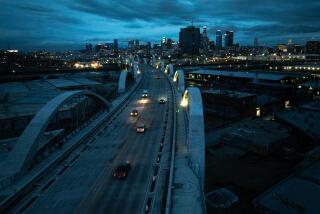Severe Signs of Rot at the Big Apple Core
- Share via
NEW YORK — “They closed the Williamsburg Bridge and it’s got everything else loused up,” the cab driver said, a magnificent understatement if there ever was one.
It was Sunday night and we were inching from J.F.K. Airport toward Manhattan like a blight, amid a caterwauling of horns and the steaming of overpowered cars ill-designed for low throttle.
“Hang on!” the driver said suddenly; “I know Queens.” He wigwagged his way across a lane of traffic, gunned the taxi up over the curb with a whanging clang of crankcase on concrete and threaded his way between a meter and a parked car. He roared across an empty lot beneath the elevated tracks and exited on the next parallel street.
We jolted down dark, narrow streets past abandoned warehouses and shuttered restaurants that had long since had their last rendezvous with ptomaine.
I saw intersections the borough president of Queens has never seen. It was like “Blade Runner East,” a tour of urban desolation. But the driver really did know Queens and at last we eased onto the 59th Street Bridge--which took 40 minutes to cross.
“They made it on a cost-efficient basis, the Williamsburg,” the driver said. “They wanted to save bucks so they didn’t use the best steel, and then they didn’t paint it for 40 years, so whaddaya expect?” The Williamsburg has rusted into a dangerous decrepitude and was closed a few days ago for inspections, but possibly forever.
The bridge is evidently only one of two or three dozen New York-area bridges that are imperiled by age and neglect. It is always tempting to turn events into metaphors. But the closing of the bridge and the traffic tie-up as big as all outdoors become their own perfect commentary on a city which--more dramatically than most--is a paradox of moldering decay and feverish construction.
The avenues are pocked with holes that would conceal a goat. Cabs, which do not slow to avoid hitting human flesh, pause respectfully before the deepest of the craters.
The city’s vast and assertive towers, now executed in Post-Wedding-Cake or Neo-Pyramid Moderne, gaze down upon peeling storefronts and eyeless brownstones occupied by squatters.
The gap between the haves and the have-nots appears more dramatic than ever, and the homeless--including the young and non-alcoholic homeless--have moved from the city center to the Upper West Side and virtually everywhere else.
It’s hard to avoid the impression that the fastest-growing segment of the population is not the aging Baby Boom but in fact the homeless. They camp in Central Park, and the penthouse dwellers on Fifth Avenue and Central Park West can see their ghostly campfires in the late winter night.
The luckless are an inescapable accusation here, as they are in Los Angeles and any other city I’ve seen in recent years. Yet New York remains an exciting place, with a 24-hour pulse that has no equal anywhere.
The skyline, seen from a distance so the stains of decay don’t show, is as breathtaking as ever. And although the theater district is an imperiled and diminishing enclave, at curtain time on any evening it carries a wonderful, buzzing expectancy.
The theaters of Shubert Alley, with their rococo ceilings and their intimacy (including grossly inadequate knee space), have become a kind of link to a different past.
It was a past that had its own cruel disparities between rich and poor, and its own angers and anxieties. But there was also an abiding conviction, so it seems, that the future lay ahead and was bound to be ever shinier, better and fairer.
Yet even amid the glamorous constructions, the conspicuous consumptions and the 24-hour hum, any true and serviceable optimism has begun to feel as rusted and endangered as the Williamsburg Bridge.
More to Read
Sign up for Essential California
The most important California stories and recommendations in your inbox every morning.
You may occasionally receive promotional content from the Los Angeles Times.













